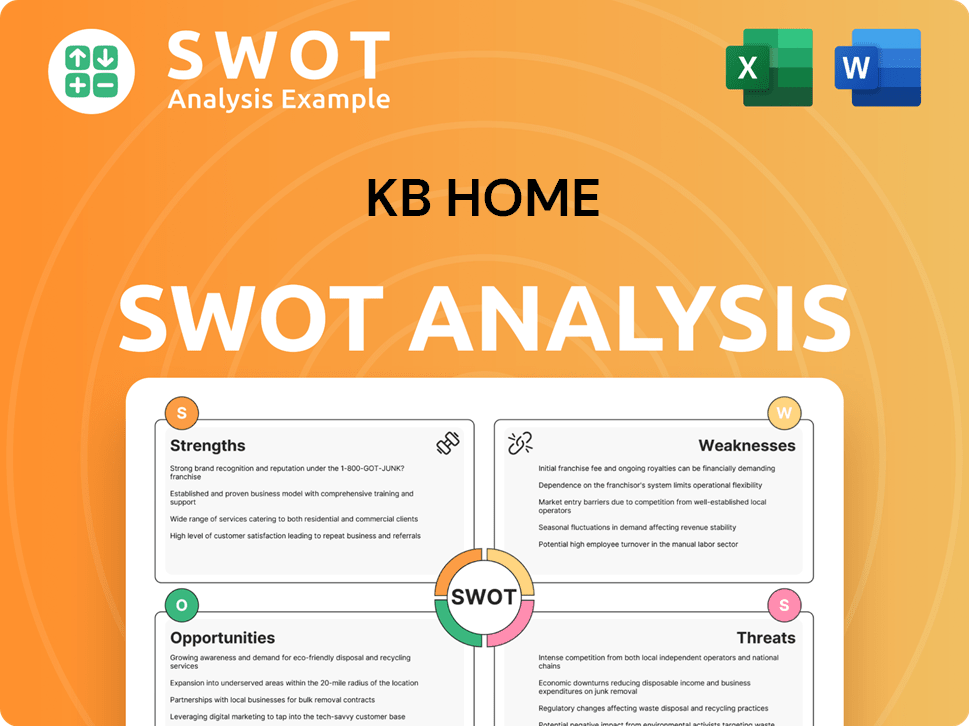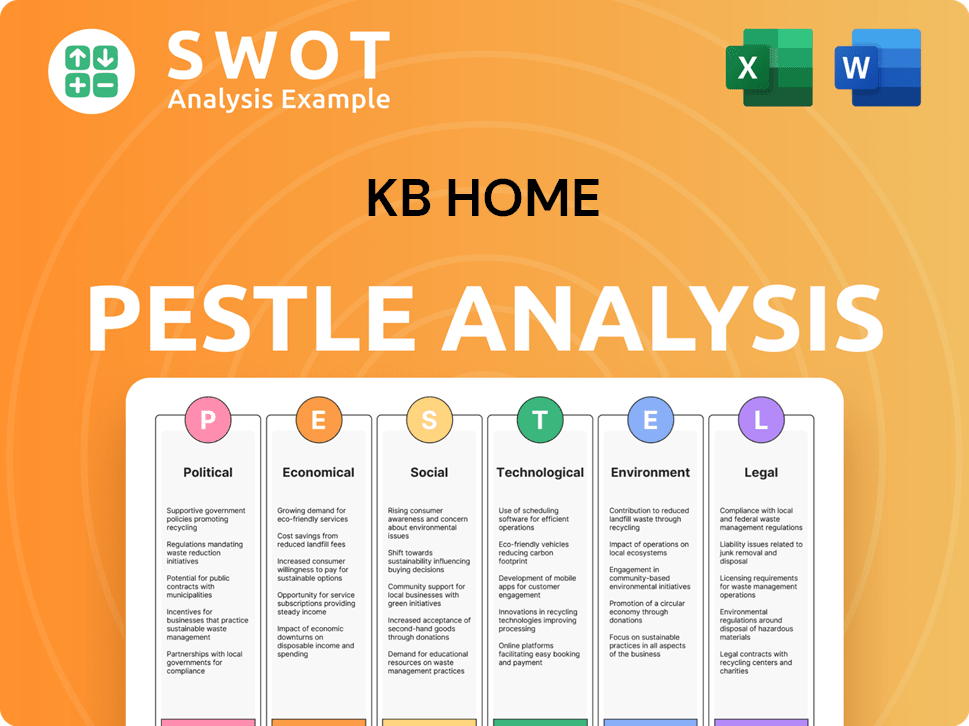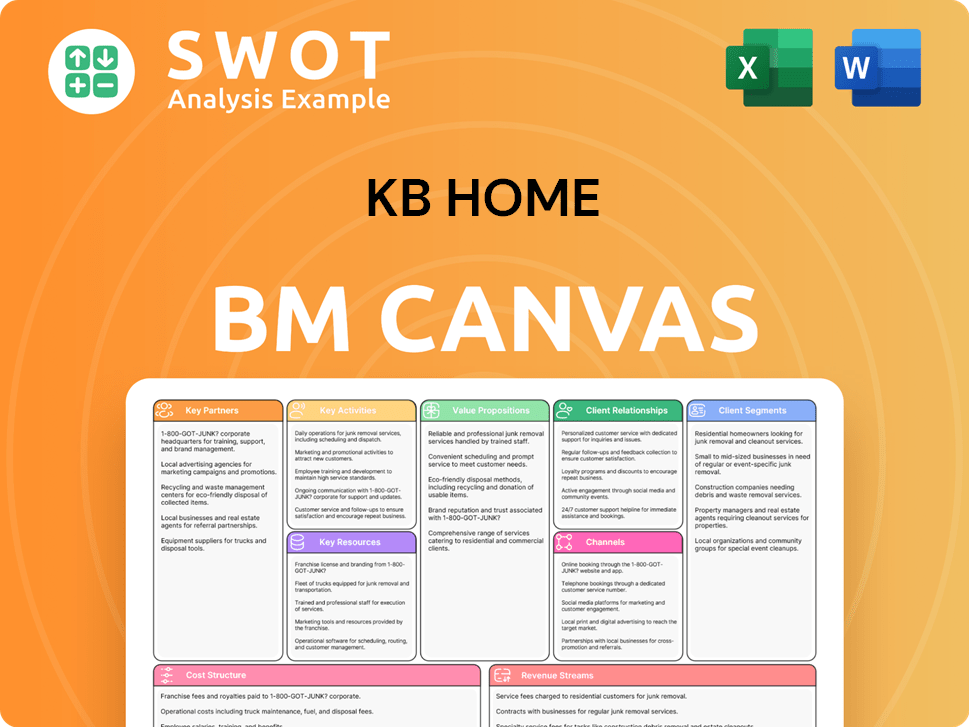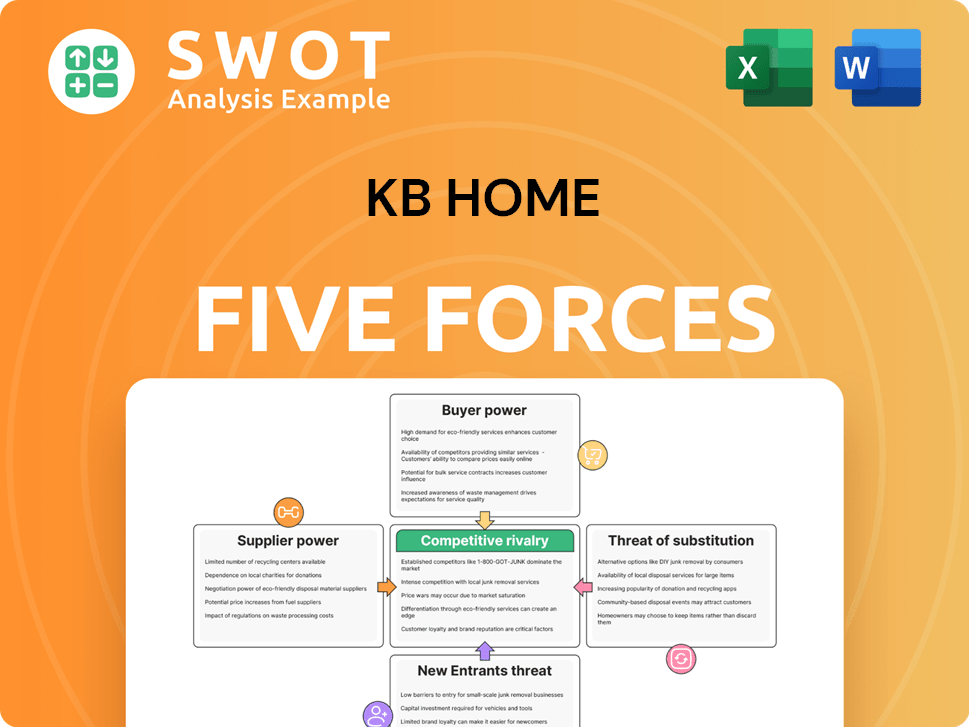KB Home Bundle
How Does KB Home Thrive in the Homebuilding Industry?
In the ever-shifting realm of real estate, understanding the KB Home SWOT Analysis is crucial for investors and strategists alike. The homebuilding industry is fiercely competitive, with market dynamics constantly reshaping the playing field. This analysis dives deep into KB Home's position, examining its strategies and rivals.

This exploration of KB Home's competitive landscape provides critical market analysis, examining its financial performance compared to competitors and its strategic partnerships. We'll explore who KB Home's main rivals are and the competitive advantages that allow it to navigate the housing market. The insights offered here are essential for anyone seeking to understand the nuances of this dynamic sector and KB Home's future outlook.
Where Does KB Home’ Stand in the Current Market?
KB Home holds a significant position within the U.S. homebuilding industry. The company's core operations revolve around the construction and sale of new single-family homes. Its 'Built-to-Order' model allows customers to customize their homes, appealing to a wide range of buyers.
The value proposition of KB Home lies in its ability to offer personalized homes across various price points. They focus on energy efficiency and smart home technologies. This strategy caters to diverse customer segments, from first-time homebuyers to those seeking move-up homes, enhancing their appeal in the competitive housing market.
KB Home's financial performance for the fiscal year ending November 30, 2024, showed total revenues of $6.7 billion. They reported a net income of $626.6 million, demonstrating strong financial health. Their strategic focus on markets experiencing growth and their ability to adapt to changing economic conditions are key strengths, as highlighted in a recent analysis of KB Home's growth strategy.
KB Home operates in 47 markets across eight states, primarily in the Sun Belt. While specific market share data varies by region, the company consistently ranks among the top builders by revenue and deliveries. This broad geographic reach is a key factor in its competitive position.
The company caters to various customer segments, from first-time homebuyers to move-up buyers. Its 'Built-to-Order' model allows for customization. This approach helps KB Home differentiate itself in the competitive landscape by offering tailored solutions.
KB Home's financial performance in fiscal year 2024 included revenues of $6.7 billion and a net income of $626.6 million. This financial strength enables the company to manage inventory and adapt to interest rate changes. These results reflect the company's ability to navigate the housing market.
KB Home's competitive advantages include its broad geographic presence and 'Built-to-Order' model. Challenges arise from competition in regions with many custom home builders. The company's focus on energy efficiency and smart home technologies helps it stay competitive.
KB Home's market position is characterized by its strong revenue, geographic diversity, and customer-focused approach. The company's ability to adapt to changing market conditions and consumer preferences is crucial for maintaining its competitive edge. The focus on sustainability and technology further strengthens its market position.
- Strong revenue and financial performance in 2024.
- Geographic presence across 47 markets.
- Emphasis on 'Built-to-Order' homes and customization.
- Focus on energy efficiency and smart home technologies.
KB Home SWOT Analysis
- Complete SWOT Breakdown
- Fully Customizable
- Editable in Excel & Word
- Professional Formatting
- Investor-Ready Format

Who Are the Main Competitors Challenging KB Home?
The Growth Strategy of KB Home involves navigating a complex competitive landscape within the homebuilding industry. This landscape includes both direct and indirect competitors, all vying for market share in the housing market. Understanding these rivals is crucial for assessing KB Home's position and potential for growth.
KB Home's competitive environment is shaped by national, regional, and local homebuilders. These entities employ various strategies, from economies of scale to niche market specialization, to attract customers. The dynamics of this competition directly impact KB Home's operations, financial performance, and strategic decisions.
KB Home faces significant competition from several publicly traded national homebuilders. These companies compete directly in similar geographic markets and target customer segments.
D.R. Horton is often the largest homebuilder by volume in the U.S., competing with KB Home on scale and geographic reach. In 2024, D.R. Horton reported revenues of approximately $36 billion, significantly outpacing KB Home's revenue. D.R. Horton's vast operations and diverse product offerings pose a substantial challenge.
Lennar Corporation is another major competitor, known for its 'Everything's Included' approach. In 2024, Lennar's revenue was around $34 billion. This strategy bundles features and upgrades, potentially attracting customers who might otherwise consider KB Home's personalization options.
PulteGroup competes across multiple brands, targeting different buyer segments. PulteGroup's revenue in 2024 was approximately $17 billion. This diversified approach allows PulteGroup to capture a wider range of potential customers.
NVR, Inc. primarily operates in the Mid-Atlantic and East Coast, focusing on a land-light strategy. NVR's revenue in 2024 was about $9 billion. This strategy provides greater financial flexibility, which can be a competitive advantage.
These competitors employ various strategies to gain market share. D.R. Horton and Lennar leverage their scale for cost efficiencies and broad market penetration. PulteGroup's diversified brand portfolio allows it to capture a wider spectrum of the market.
KB Home also faces indirect competition from regional builders and the resale market. The housing market is also influenced by emerging players focusing on niche markets.
- Regional Builders: These builders may offer highly localized expertise or custom home options.
- Resale Market: Provides an alternative for homebuyers, influencing overall demand.
- Emerging Players: Often focused on niche markets like sustainable or modular homes, posing a potential long-term disruption.
- Mergers and Acquisitions: Industry consolidation can create larger, more dominant players.
KB Home PESTLE Analysis
- Covers All 6 PESTLE Categories
- No Research Needed – Save Hours of Work
- Built by Experts, Trusted by Consultants
- Instant Download, Ready to Use
- 100% Editable, Fully Customizable

What Gives KB Home a Competitive Edge Over Its Rivals?
The KB Home competitive landscape is shaped by its customer-centric approach, operational efficiency, and focus on sustainability. Their 'Built-to-Order' model allows for home personalization, fostering customer loyalty. This strategy sets them apart in the homebuilding industry, providing a unique selling proposition.
Operationally, KB Home leverages economies of scale, securing favorable pricing on materials and labor. They invest in technology to streamline processes, enhancing the homebuying experience. Their strong brand equity, built over six decades, contributes to customer trust and recognition in the market. A detailed market analysis reveals how these factors impact their competitive position.
Furthermore, KB Home is a leader in energy-efficient homebuilding, with all homes ENERGY STAR certified. This focus on sustainability appeals to environmentally conscious buyers and reduces homeowner utility costs. These advantages have evolved from a focus on affordability to a blend of personalization, efficiency, and sustainability.
The 'Built-to-Order' model allows homebuyers to customize their homes. Customers select from various floor plans, structural options, and design finishes. This customization enhances customer satisfaction and loyalty, setting them apart from competitors.
As a large national builder, KB Home benefits from economies of scale. They negotiate favorable pricing on materials and labor. Technology investments streamline construction and enhance the homebuying experience.
All KB Home homes are ENERGY STAR certified. The company has been recognized for its sustainability efforts. This focus appeals to environmentally conscious buyers and reduces homeowner utility costs.
KB Home has a strong brand built over more than six decades. This contributes to customer trust and recognition in the market. The established brand is a key competitive advantage.
KB Home's competitive edge stems from its unique 'Built-to-Order' model, operational efficiency, and commitment to sustainability. The company's focus on customer satisfaction and energy-efficient homes differentiates it in the housing market. These advantages are supported by a strong brand reputation and strategic investments.
- 'Built-to-Order' customization enhances customer satisfaction.
- Economies of scale improve cost efficiencies.
- ENERGY STAR certification appeals to environmentally conscious buyers.
- Strong brand equity fosters customer trust.
While the 'Built-to-Order' model can be imitated, KB Home's established infrastructure and brand reputation make it challenging for competitors to replicate its full suite of offerings. For a deeper dive into how KB Home approaches its marketing, consider exploring the Marketing Strategy of KB Home. In 2024, the homebuilding industry continues to evolve, with KB Home adapting its strategies to meet changing consumer demands and market dynamics. The company's ability to maintain its competitive position depends on its continued innovation and responsiveness to market trends. Analyzing KB Home's financial performance compared to competitors and examining its geographic market presence provides further insights into its competitive standing. The company's focus on customer satisfaction, building quality, and sustainability initiatives are crucial factors influencing its future outlook.
KB Home Business Model Canvas
- Complete 9-Block Business Model Canvas
- Effortlessly Communicate Your Business Strategy
- Investor-Ready BMC Format
- 100% Editable and Customizable
- Clear and Structured Layout

What Industry Trends Are Reshaping KB Home’s Competitive Landscape?
The Target Market of KB Home and the homebuilding industry are currently experiencing a confluence of trends, presenting both challenges and opportunities for KB Home. Technological advancements, regulatory changes, and shifting consumer preferences are reshaping the industry. Simultaneously, global economic factors like interest rates and supply chain disruptions significantly impact construction costs and buyer affordability, influencing the competitive landscape.
For KB Home, these dynamics require strategic navigation. Rising interest rates and material costs could affect profitability and demand. However, the ongoing demand for new homes, especially in the Sun Belt, and the increasing consumer interest in sustainable housing offer significant advantages. KB Home's focus on energy-efficient homes and operational efficiency positions it to capitalize on these opportunities and maintain its competitive edge.
The homebuilding industry is seeing greater adoption of smart home technology and advanced construction techniques. Regulatory changes, particularly regarding environmental standards and affordable housing, are becoming more prevalent. Consumer preferences are shifting towards energy-efficient homes and flexible living spaces. These trends directly impact the KB Home's market analysis.
Rising interest rates and increased material costs pose significant challenges to profitability. Intense competition from other national builders and the emergence of new construction technologies could disrupt traditional business models. Economic shifts, including inflation and supply chain issues, directly impact construction costs and buyer affordability, affecting KB Home's financial performance.
Strong demand for new homes, especially in the Sun Belt, continues to drive growth for KB Home. The increasing consumer focus on energy efficiency and sustainability aligns with KB Home's expertise. Opportunities exist in expanding into underserved markets, leveraging technology, and forming strategic partnerships. This offers a competitive advantage for KB Home.
Focusing on personalization, sustainability, and operational efficiency is crucial for KB Home. Adapting to market fluctuations and capitalizing on emerging demands for modern, energy-efficient housing is essential. Strategic partnerships and innovative home designs can enhance KB Home's competitive advantages within the housing market.
The homebuilding industry faces fluctuating interest rates, which influence buyer affordability and demand. Supply chain disruptions and rising material costs are impacting construction expenses. Consumer preferences for sustainable and technologically advanced homes are increasing, creating a need for innovation and adaptation within the real estate developers sector.
- Interest Rates: The Federal Reserve's decisions on interest rates directly affect mortgage rates, influencing housing demand. As of May 2024, the average 30-year fixed mortgage rate is around 7%, impacting affordability.
- Material Costs: Lumber prices, for example, have shown volatility. In early 2024, prices were around $400-$600 per thousand board feet, impacting construction costs.
- Consumer Preferences: Demand for energy-efficient homes is growing. Approximately 70% of homebuyers now prioritize energy efficiency features, according to recent surveys.
- Geographic Market Presence: KB Home has a significant presence in the Sun Belt region, which has seen increased population growth and housing demand.
KB Home Porter's Five Forces Analysis
- Covers All 5 Competitive Forces in Detail
- Structured for Consultants, Students, and Founders
- 100% Editable in Microsoft Word & Excel
- Instant Digital Download – Use Immediately
- Compatible with Mac & PC – Fully Unlocked

Related Blogs
- What are Mission Vision & Core Values of KB Home Company?
- What is Growth Strategy and Future Prospects of KB Home Company?
- How Does KB Home Company Work?
- What is Sales and Marketing Strategy of KB Home Company?
- What is Brief History of KB Home Company?
- Who Owns KB Home Company?
- What is Customer Demographics and Target Market of KB Home Company?
Disclaimer
All information, articles, and product details provided on this website are for general informational and educational purposes only. We do not claim any ownership over, nor do we intend to infringe upon, any trademarks, copyrights, logos, brand names, or other intellectual property mentioned or depicted on this site. Such intellectual property remains the property of its respective owners, and any references here are made solely for identification or informational purposes, without implying any affiliation, endorsement, or partnership.
We make no representations or warranties, express or implied, regarding the accuracy, completeness, or suitability of any content or products presented. Nothing on this website should be construed as legal, tax, investment, financial, medical, or other professional advice. In addition, no part of this site—including articles or product references—constitutes a solicitation, recommendation, endorsement, advertisement, or offer to buy or sell any securities, franchises, or other financial instruments, particularly in jurisdictions where such activity would be unlawful.
All content is of a general nature and may not address the specific circumstances of any individual or entity. It is not a substitute for professional advice or services. Any actions you take based on the information provided here are strictly at your own risk. You accept full responsibility for any decisions or outcomes arising from your use of this website and agree to release us from any liability in connection with your use of, or reliance upon, the content or products found herein.